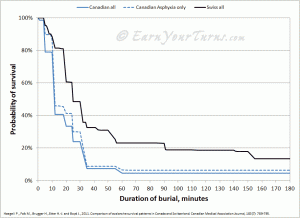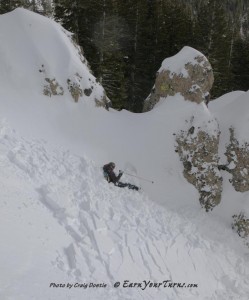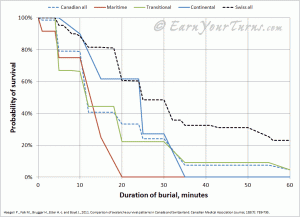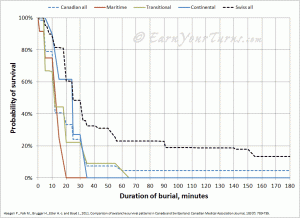An updated study of avalanche survival curve , spearheaded by Dr. Pascal Haegeli—an avalanche researcher in Vancouver, British Columbia—and published in relative obscurity in the Canadian Medical Association Journal last year indicate that completely buried avalanche victims die significantly more quickly than previously thought, at least in Canada compared to Switzerland.

Fig. 1 - Avalanche Survival Curves:
Canadian (blue) VS Swiss (blk)
Canadian dashed lines are for asphyxia only deaths.
For years avalanche educators have reasoned that the commonly accepted survival curve derived by Brugger and Falk’s study of Swiss avalanche incident data might not accurately reflect avalanche survival in North America. The rationale was simple; nearly all the Swiss data was based on incidents above treeline while in the US and Canada skiing among trees is more common than not. As noted in the CMAJ report, “the universal validity of the [Swiss] survival curve and recommendations derived from it [were] unknown.”
Finally Pascal Haegeli decided to put the speculation to rest and the results are sobering. The commonly accepted survival phase for burial in an avalanche is about 18 minutes long based on Brugger and Falks analysis of 946 Swiss avalanche fatalities from 1980 to 2005. This more recent study of 301 fatalities in Canada suggests 10 minutes would be a more appropriate guideline, almost half the reigning mindset.
According to this study, if you’re buried in an avalanche in Canada your chances of survival drop precipitously to only 79% after a mere five minutes where they hold until 10 minutes out, then continue falling into the abyss of eternity. By the time 15 minutes have passed, only 40% survive, and there isn’t much life left after that. If you look at the curves, you can see that the Swiss and Canadian survival curves differ in three main aspects:
- The Canadian curve seems to drop immediately from the start. This difference might be associated with the higher rate of trauma among Canadian avalanche fatalities as shown by the study of Boyd et al. (2009), which was also published in CMAJ. You can actually show this by removing the trauma fatalities from the Canadian dataset and calculating an ‘asphyxia-only’ curve. In Fig. 2, the Swiss and the Canadian asphyxia-only’ curves are quite similar in the first 10 minutes. So victims who do not have serious traumatic injuries have about the same chances of survival in the first ten minutes of burial.
- The main drop in the survival curve, which is associated with the onset of asphyxia, seems to occur significantly earlier in the Canadian dataset. This study shows that the more maritime the snow climate, the earlier the onset of asphyxia. When you look only at this port of the survival curve, you see that the Canadian curve from the Rockies looks actually quite similar to the Swiss curve. On the other side the Coast mountain curve (maritime) drops much earlier and the curve from the Columbia mountains (transitional) is in between.
- When you look at the long-term survival of avalanche victims (60 min and longer) you can see that the survival changes in Canada are much lower than in Switzerland. We do not have any data about this, but we suspect that the remoteness of the Canadian mountains might at least part of the reason. In Switzerland, it is possible to have advanced life support at the accident site much more quickly and the time it take to transport the victim to an advanced medical facility is much shorter. So in addition to the conditions in the avalanche, the medical support you get once the victim is extricated also matters much.
And if you happen to get buried in a moist, maritime snowpack, by 20 minutes you’re as good as dead.
Overall survivability is about the same for either country; 46.2% in Canada versus 46.9% in Switzerland. However, survivability over time drops faster in Canada than Switzerland. The equality in overall survival is attributed to faster extrication times in Canada due to companion rescue efforts. The 10 minute guideline means avoiding getting caught, or buried, through the use of airbag packs or other survival strategies. In the event people are caught and buried, efficient shoveling techniques are essential for survival.

In a related study by Jeff Boyd in 2009 24% of victims died from trauma, while 76% were due to asphyxia, although 10% of these had severe enough trauma that it likely contributed to their demise. Thus, it would not be a stretch to suggest that 33% of non-survivors had major trauma . The most important common factor where trauma was involved was the finding that two-thirds of these trauma related deaths involved collisions with trees.
Within the dataset analyzed for Hagaeli’s study, only 18.9% of Canadian avalanche deaths were due to trauma, the rest to asphyxia. Pascal Hageali suspects part of the reason for the lower trauma numbers is because not all trauma related incidents had good burial time information recorded.
This study did more than just tabulate overall survival rates for avalanche victims, it also broke out the differences in survival rates for maritime, transitional, and continental snowpacks. Not surprisingly the survival rate was the lowest in a maritime snowpack (41.7%) versus continental (43.6%) or transitional (50.8%). Surprisingly the trauma rate in maritime was only 5% and the average burial depth one meter (the sample size for maritime snowpack incidents was small enough to make this a suspicious number). The same average depth was noticed for a transitional snowpack, but the incidence of trauma increased to 30%. In a continental snowpack trauma accounted for 9.6% of deaths, but the average burial depth was deeper, 1.5 meters. There was also a higher incidence of snowmobile deaths (27.7%) in a continental snowpack compared to a transitional (19.7%) or maritime (11.1%) snowpack.
If that all seems like a lot to digest in such a short space, it is.
The bottom line is much like the rule of climbing with crampons – don’t fall, or in the case of avalanches – don’t get caught.
Take an avalanche course to learn as much as you can to 1) avoid getting caught, 2) know how to avoid getting buried if caught (use an airbag pack, jettison your board(s)), and 3) know how to search and dig so you can unbury a friend fast enough to save them if they are caught, and if you’re the one buried, how to survive long enough until they dig down to you (use an AvaLung).
Ski hard, play fair, and come back home.
Link to full article in CMAJ, March 2011 here.
Patterns of death among avalanche fatalities (Boyd et al, 2009)
© 2012



1 comment
3 pings
Thanks for posting this sobering report highlighting the importance of avoidance. What I found interesting and perhaps a no-brainer is that once buried, you’re chances of survival have little to do with whether its a coastal or continental snowpack.
[…] Previous burial survival times were researched in Switzerland. It was thought that North American burial survival times were shorter due to a different type of snowpack. This new study shows that they are. “The rationale was simple; nearly all the Swiss data was based on incidents above treeline while in the US and Canada skiing among trees is more common than not.” – earnyourturns.com […]
[…] Posts Canadian study reduces avalanche survival time Buried […]
Thank you very much for your blog.
I enjoyed reading this article.